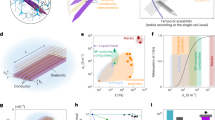Abstract
In order to extract learning algorithms from living neural aggregates it would be advantageous to achieve one-to-one neuron-electrode interfacing with in vitro networks. Towards this goal, we have developed a hybrid glass-elastomer technology, which allows topology specification in small networks (of the order of 10 neurons) and recording of extracellular potentials from individual neurites grown through microfluidic channels. Here we report on progress towards adhesion-free placement of cells within microwells, promotion of neurite growth and recording of intra-channel extracellular spikes.
Preview
Unable to display preview. Download preview PDF.
Similar content being viewed by others
References
Claverol-Tinturé, E., Ghirardi, M., Fiumara, F., Rosell, X., Cabestany, J.: Multielectrode arrays with elastomeric microstructures for neuronal patterning towrds interfacing with uni-dimensional neuronal networks. Submitted to J. Neural Eng. (2005)
Xia, Y., Whitesides, G.M.: Soft lithography. Ann. Rev. of Materials Science 28(1), 153–184 (1998)
Pine, J.: Recording action potentials from cultured neurons with extracellular microcircuit electrodes. J. Neurosci Methods 2(1), 19–31 (1980)
Tiwari, S.K., Woodruff, M.L.: Helix aspersa neurons maitain vigorous electrical activity when co-cultured with intact H. aspersa ganglia. Comp. Biochem. Physiol. 101C(1), 163–174 (1992)
Author information
Authors and Affiliations
Editor information
Editors and Affiliations
Rights and permissions
Copyright information
© 2005 Springer-Verlag Berlin Heidelberg
About this paper
Cite this paper
Claverol-Tinturé, E., Rosell, X., Cabestany, J. (2005). Interfacing with Patterned in Vitro Neural Networks by Means of Hybrid Glass-Elastomer Neurovectors: Progress on Neuron Placement, Neurite Outgrowth and Biopotential Measurements. In: Cabestany, J., Prieto, A., Sandoval, F. (eds) Computational Intelligence and Bioinspired Systems. IWANN 2005. Lecture Notes in Computer Science, vol 3512. Springer, Berlin, Heidelberg. https://doi.org/10.1007/11494669_53
Download citation
DOI: https://doi.org/10.1007/11494669_53
Publisher Name: Springer, Berlin, Heidelberg
Print ISBN: 978-3-540-26208-4
Online ISBN: 978-3-540-32106-4
eBook Packages: Computer ScienceComputer Science (R0)




